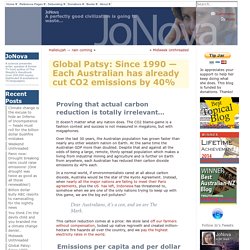

JoNova.
Fossil Fuel Subsidies. CO2 Emissions. Global Patsy: Since 1990 — Each Australian has already cut CO2 emissions by 40% Proving that actual carbon reduction is totally irrelevant… It doesn’t matter what any nation does.

The CO2 blame-game is a fashion contest and success is not measured in megatons, but with megaphones. Over the last 30 years, the Australian population has grown faster than nearly any other western nation on Earth. At the same time the Australian GDP more than doubled. Despite that and against all the odds of being a large, remote, thinly spread population which makes a living from industrial mining and agriculture and is further on Earth from anywhere, each Australian has reduced their carbon dioxide emissions by 40% each. In a normal world, if environmentalists cared at all about carbon dioxide, Australia would be the star of the Kyoto Agreement. Dear Australians, it’s a con, and we are The Mark. World Energy Policies A Minefield. That is the conclusion reached by seasoned energy analyst Gail Tverberg after asking the question: Do the World’s Energy Policies Make Sense?

The article title is a link to her post at her blog Our Finite World. Excerpts in italics with my bolds. The world today has a myriad of energy policies. One of them seems to be to encourage renewables, especially wind and solar. Another seems to encourage electric cars. Study Says Fracking is Saving Families $2,500 Annually, Significantly Lowering Greenhouse Gas Emissions. Research & Commentary by Tim Benson, The Heartland Institute A report released in October 2019 by the White House Council of Economic Advisors (CEA) estimates increased oil and natural gas production from hydraulic fracturing (“fracking”) saves American families $203 billion annually on gasoline and electricity bills.

This breaks down to $2,500 in savings per family per year. “From 2007 to 2019, innovation in shale production brought an eight-fold increase in extraction productivity for natural gas and a nineteen-fold increase for oil,” the report states. “These productivity gains have reduced costs and spurred production to record-breaking levels. As a result, the United States has become the world’s largest producer of both commodities, surpassing Russia in 2011 (for natural gas) and Saudi Arabia and Russia in 2018 (for oil). For low-income families, who spend the largest share of their income on energy costs, these savings are very significant. The global climate alarmism propaganda campaign has failed – fossil fuels have priority. Australia installs more renewables than anywhere else but national emissions stay the same. Australians are installing renewable energy, per capita, faster than any place on Earth, or at least we were until 2020 when the subsidies and schemes ran out.

Per capita, Australia (all shades of red) is installing renewables The Quarterly update for the Greenhouse Gas inventory is out and we can see just how much difference all those renewables make, which is almost nothing. Emissions have flatlined. Australians are paying record prices, risking blackouts, buying batteries and synchronous condensors, building new billion dollar interconnectors, losing companies overseas, and suffering voltage spikes. Love Of The Cloud Is Making A Green Energy Future Impossible. The global information infrastructure already consumes more electricity than is produced by all of the world’s solar and wind farms combined.

Far from saving energy, our AI-enabled workplace future uses more energy than ever before. An epic number of citizens are video-conferencing to work in these lockdown times. But as they trade in a gas-burning commute for digital connectivity, their personal energy use for each two hours of video is greater than the share of fuel they would have consumed on a four-mile train ride. Add to this, millions of students ‘driving’ to class on the internet instead of walking. Meanwhile in other corners of the digital universe, scientists furiously deploy algorithms to accelerate research. This grand ‘experiment’ in shifting societal energy use is visible, at least indirectly, in one high-level fact set. Analysts have widely documented massive increases in internet traffic from all manner of stay-at-home activities. Full post.
Europe and UK Energy Mix. US and Canada Energy Mix. A Comparison of Energy Densities of Prevalent Energy Sources in Units of Joules Per Cubic Meter - Fusion 4 Freedom. Bradley E.

EROI of different fuels and the implications for society. 1.

Introduction Energy has played a critical role throughout human society's demographic, economic and social development. The availability and quality of various energy and material resources to a society is linked to the general trend of the settlement, growth, and eventual decline experienced by each civilization (White, 1959, Tainter, 1988). BP Energy Review 2018. Required Reading: NIPCC 2019 Summary on Fossil Fuels. Those who seek the truth about global warming/climate change should welcome this latest publication from the Nongovernmental International Panel on Climate Change (NIPCC).

Excerpts from the Coauthors’ introduction in italics with my bolds. H/T Lubos Motl Climate Change Reconsidered II: Fossil Fuels assesses the costs and benefits of the use of fossil fuels (principally coal, oil, and natural gas) by reviewing scientific and economic literature on organic chemistry, climate science, public health, economic history, human security, and theoretical studies based on integrated assessment models (IAMs). It is the fifth volume in the Climate Change Reconsidered series and, like the preceding volumes, it focuses on research overlooked or ignored by the United Nations’ Intergovernmental Panel on Climate Change (IPCC).
NIPCC was created by Dr. The NIPCC authors do something their IPCC counterparts never did: conduct an evenhanded cost-benefit analysis of the use of fossil fuels. Energy Production & Changing Energy Sources. Empirical View Global total energy production – long-run view by source Let's first take a look at how global energy production- both in terms of quantity and source- have changed over the long-term. In the visualisation below, we have plotted global energy consumption from 1800 through to 2015. Note that you can use the absolute/relative toggle on the chart to view these in absolute numbers or as the percentage of the global total. Another Look At The Fuel Mix. The New Gas Revolution That Could Make Renewable Energy Obsolete. If the Net Zero power plant performs as expected this is a real game changer for natural gas.

Since the United States is sitting on more natural gas than any country in the world, and it’s getting cheaper to get it out of the ground, this is no small game to change. An actual game changing technology is being demonstrated as we sit in our air-conditioned abodes reading this. And it is being demonstrated by North Carolina–based Net Power at a new plant in La Porte, Texas. The process involves burning fossil fuel with oxygen instead of air to generate electricity without emitting any carbon dioxide (CO2). Not using air also avoids generating NOx, the main atmospheric and health contaminant emitted from gas plants. Included in a group of technologies known as carbon capture and sequestration (CCS), zero-emission fossil fuel plants have been a dream never realized in practice, as it always seems to cost a lot, adding between 5¢ and 10¢ per kWh. This is key. Exaggerating Green Energy Supply. What would life be like without fossil fuels such as gas and oil?
Leftists like Bill McKibben of 350.org suffer from irrational fantasies that lead them to believe that we can move society forward without all the benefits that petroleum brings to our modern society.

They’re dead wrong of course, and this short humorous video illustrates just what life might be like without the many products and energy sources that are derived from petroleum. My favorite is ink, which if we didn’t get from petroleum, we wouldn’t have to see print editions of NYT, WaPo, and the Lost Angeles Times, to name a few. You also wouldn’t be able to read this article, because the very keyboard I am typing this on is made from plastic, which you guessed it, is derived from petroleum. Democrats deliberately conceal global energy & CO2 emissions realities from the public.
Guest essay by Larry Hamlin. Developing nations surging energy use shatters UN & California’s climate alarmism crusade. Guest essay by Larry Hamlin California has updated its GHG emissions data for year 2017 showing a decrease of about 5 million metric tons of GHG emissions since 2016. The results of the states latest emissions assessment exposes significant problems regarding the state’s future and unrealistic emissions reduction goals as well as further establishing the overwhelming irrelevance of the state’s inane “fighting climate change” political propaganda dishonesty.
An L. U.S. media conceal 4.5+ billion tons increase of CO2 by developing nations – push meaningless “sustainability” propaganda agenda. Developing nations latest decade of energy & emissions growth torpedoes alarmist global emissions control scam. Guest essay by Larry Hamlin The UN has been pursuing global emissions policy for decades that are intended to provide for the establishment of global government schemes allowing it to control world emissions. No fewer than 24 United Nations Climate Change Conferences have been held at various global locations since 1995 under its Conference of the Parties (COP) legal framework.
African Leaders Say Their Need For Coal And Oil Outweighs Climate Concerns. The Middle East, Africa, and Asia now drive nearly all global energy consumption growth. From The EIA January 9, 2019 The Middle East, Africa, and Asia now drive nearly all global energy consumption growth Source: U.S.